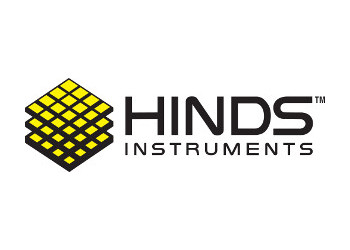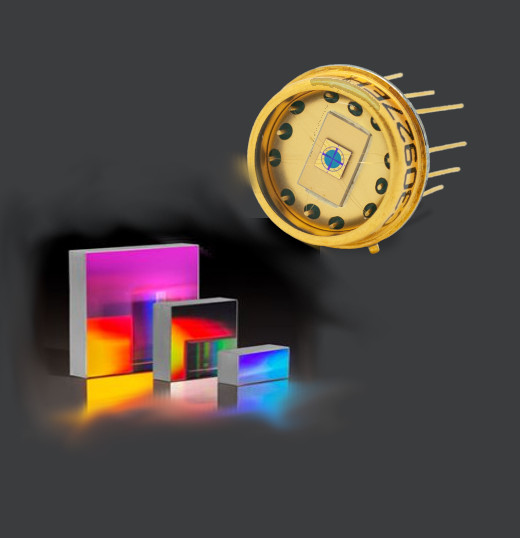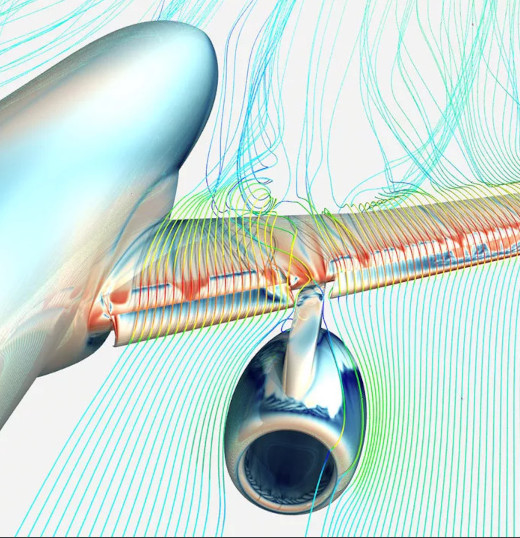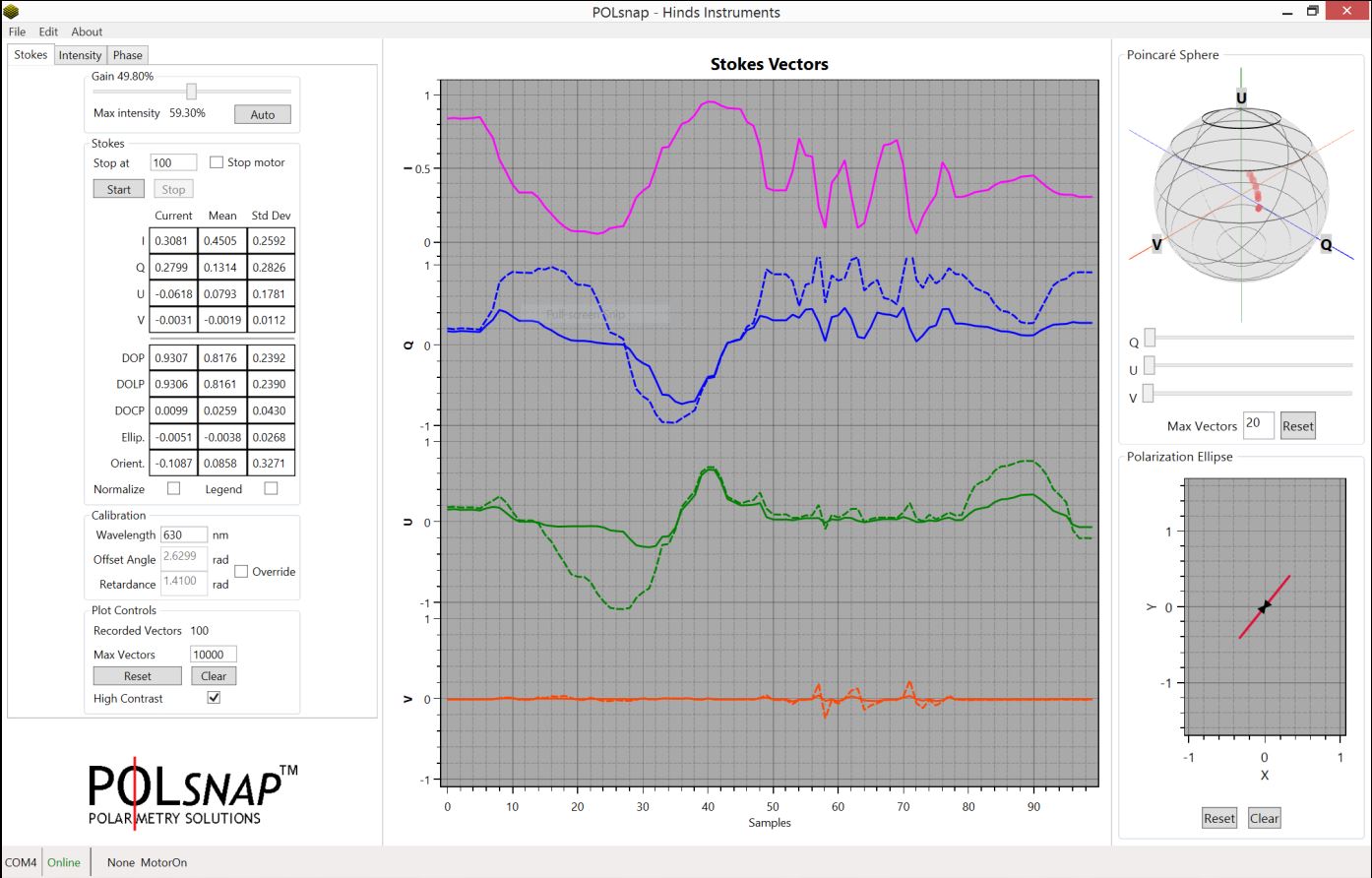Polarymetry

Oferujemy gotowe systemy jak i komponenty
Polarymetry Stokesa i macierzy Muellera

Hinds Instruments oferuje szeroką gamę instrumentów do oceny polaryzacji i światła. Wiele z systemów Hinds Instruments zostało uznanych za przełomowe osiągnięcia w branży i otrzymało liczne nagrody R&D 100 Awards oraz Photonics Circle of Excellence. Systemy te są szeroko stosowane przez najlepszych naukowców, laboratoria krajowe, uniwersytety i klientów przemysłowych na całym świecie.
W ofercie SPECTROPOLU (Hinds Instruments) dwa rodzaje polarymetrów:
- Polarymetry Stokesa - urządzenia do pomiarów podstawowych polaryzacji światła i zachodzących zmian w polaryzacji w konfiguracji standardowej i indywidualnej (PolSNAP) Za pomocą polarymetru Stokesa możliwe jest scharakteryzowanie obiektu poprzez wyznaczenie parametrów wektora Stokesa promieniowania odbitego bądź emitowanego przez ten obiekt.
- Polarymetry macierzy Muellera (Elipsometr 2-MGEM i Exicor 150XT). Za pomocą polarymetru macierzy Muellera są określane cechy obiektu poprzez macierz Muellera transmitancji bądź reflektancji, tj. poprzez informacje o sposobie modyfikowania polaryzacji przez obiekt.
Masz pytania ?
- Polarymetry - wektor Stokesa
- PolSNAP - Polarymetr Stokesa
- Polarymetr macierzy Muellera - Elipsometr 2-MGEM
- Polarymetr macierzy Muellera - Exicor 150XT
Polarymetry - wyznaczanie wektora Stokesa

Systemy polarymetryczne Stokesa firmy Hinds Instruments oferują niezrównaną czułość pomiaru stanu polaryzacji wiązki światła lub źródła. Wykorzystując solidną, dopracowaną technologię, nasze polarymetry Dual PEM Stokes określają ilościowo wszystkie 4 parametry tworzące tzw. wektor Stokesa za pomocą jednego pomiaru i bez ruchomych części. Doskonała czułość, powtarzalność i prosta obsługa platformy Dual PEM Stokes Polarimeter sprawiły, że system ten jest nieoceniony w wymagających zastosowaniach do charakteryzacji komponentów optycznych, astronomii, badaniach i produkcji światłowodów oraz kontroli jakości lasera.
- Stosowany do badań naukowych
- Brak ruchomych części
- Brak nieprecyzyjnych, generujących hałas rotatorów
- Modulacja wysokiej prędkości (> 40 kHz)
- Szybko: > 100 znormalizowanych zestawów parametrów Stokesa na sekundę
- Natychmiastowe, jednoczesne pełne przechwytywanie i wyświetlanie danych
Określenie stanu polaryzacji (SoP) światła poprzez wyznaczanie parametrów wektorowych Stokesa.
Stan Polaryzacji (SOP)
The State of Polarization (SOP) and Degree of Polarization (DOP) are characterized by determining the 4 Stokes parameters of light.
SOP is represented as a position on the Poincaré sphere
and DOP is calculated from the Stokes parameters, I, Q, U and V (sometimes represented as S1, S2, S3, and S4).
The light being measured can be from a laser, a fiber, a broadband source or an astronomical body like the sun or a star. The system measures and instantaneously displays the value of each of the normalized Stokes parameters, as well as the position on the Poincare´ sphere. The DOP, DOLP and DOCP are also displayed.
The turnkey system includes an optical module, an electronic module, a complete software package, and a PC with monitor. The optical module, including two photoelastic modulators (PEMs), generates all 4 Stokes parameters with a single measurement. Various standard options are available, including versions for single wavelength or spectroscopic measurements. Systems are available for the visible, NIR, IR and DUV. The software package is designed to calibrate the PEMs for changing wavelengths and a fiber optic input is available. The electronic signals can be processed through either Fourier analysis of waveforms or lock-in amplifiers depending on the requirements of a specific application.
Hardware Features
- Dual photoelastic modulator technology
- No moving components
- Fast and simultaneous measurement of all Stokes parameters
- Sturdy mechanical modules
Software Features
- Real time display of all normalized Stokes parameters
- DOP, DOCP and DOLP
- Poincare’ sphere and polarization ellipse
- Statistical analysis
- Wavelength selection
- Measurement points selection and display
- Data archiving
Specifications
- UV-Vis System: 180 nm – 850 nm
- NIR System: 800 nm – 2.5 µm
- Mid-IR System: 1.5 µm – 15 µm
- NIR Fiber Polarimeter: 1330 nm and 1550 nm
- Stokes parameter accuracy: 1%
- Stokes parameter sensitivity: 0.0005
Options Available
- Fiber Optic Input
- Spectroscopic Scanning
- Sample Stage
- DUV Wavelength Measurements
- Fiber Optic Software Modifications
- High Sensitivity Demodulation
FURTHER READING:
PolSNAP - Polarymetr Stokesa

Określenie stanu polaryzacji (SoP) i stopnia polaryzacji (DoP) światła poprzez wyznaczanie parametrów wektorowych Stokesa.
PolSNAP to kompaktowy polarymetr Stokesa firmy Hinds Instruments, firmy z 50-letnim doświadczeniem w polarymetrii.
Ten stacjonarny system „pod klucz” generuje wszystkie cztery parametry Stokesa i wyświetla je graficznie na trzy różne sposoby.
Osiągalna powtarzalność 0,06%, a precyzja w granicach 5% (VIS) i 7% (NIR).
PolSNAPTMApplications:
• Free Space and Fiber Polarimetry
• Degree of Polarization and State of Polarization Measurements
• Optical Component Alignment
• Fiber Optic Polarization Measurements
• Laser Polarization State
Features:
• Internal optical system, drive electronics and detection electronics.
• No additional consoles or electronics.
• Small size - fits in your hand
• Connected via USB
• Fast measurement speed: 4 Stokes vectors per second (2000 samples per second).
• Easy-to-use software - for use with Windows 7 or Windows 10 systems.
• Mounting options:
→ 30 mm cage mount
→ 2x M4 / ¼-20 post mount
SPECIFICATIONS
| Optical Parameters | VIS | NIR |
|---|---|---|
| Wavelength | 450 - 700 nm | 800 - 1600 nm |
| Dynamic Range | -37 dBm - 3 dBm | -34 dBm - 7 dBm |
| 200 nW - 2 mW | 400 nW - 5 mW | |
| Sampling Rate | Default 2000 samples/s | |
| Maximum 2000 samples/s | ||
| Stokes Vectors | Stokes 4 Stokes Vectors/s | |
| Intensity 2600/s | ||
| Measurable SOP | Entire Poincaré Sphere | |
| Azimuth Accuracy | ± 0.5° | ± 0.6° |
| Ellipticity Accuracy | ± 0.5° | ± 1.15° |
| Accuracy | ± 5% | ± 7% |
| Precision | 0.06% | 0.06% |
| Free Space Aperture | 10mm | 10mm |
| Diode Active Area | 25mm2 | 20mm2 |
| Input Fiber Connector | 30 mm Cage Mount | |
| Additional Specifications | ||
| Beam Alignment | No special tools required | |
| Command and Control Interface | USB 2.0 Micro / Serial SCPI | |
| Input Power Supply | External Power Supply | |
| DS15 Power Supply Ratings | 24V; 2.71A | |
| Dimensions | 49 mm x 79 mm x 79 mm | |
| 1.9" x 3.1" x 3.1" | ||
| Bottom Mounting Features | Two (M4) 1/4-20 Threaded Holes | |
| Weight | 0.28 kg (0.62lb) | |
Figure 1. PolSNAPTM Software
FURTHER READING:
Polarimetry Applications
Stokes Polarimetry Techniques
Elipsometr 2-MGEM - Polarymetr Muellera

Elipsometr jest szybszy, dokładniejszy i zbiera znacznie więcej danych niż poprzednie techniki pomiaru współczynnika anizotropii optycznej.
Opracowany we współpracy z Oak Ridge National Laboratory nowy instrument pogłębia wiedzę na temat paliw jądrowych czwartej generacji i charakterystyk polaryzacji odbiciowej.
System pomiaru współczynnika anizotropii optycznej 2-MGEM jest mikroskopem polaryzacyjnym o normalnym zdarzeniu, przeznaczonym do pomiaru próbki matrycy Muellera i jest zdobywcą nagrody 2008 R&D 100 Award.
2-MGEM Optical Anisotropy Factor Measurement System
Developed in cooperation with Oak Ridge National Laboratory, a new instrument is advancing the understanding of 4th Generation nuclear fuels and reflected polarization characteristics.
The 2-MGEM Optical Anisotropy Factor Measurement System is a normal-incidence polarization reflection microscope designed to measure the sample Mueller matrix and is a 2008 R&D 100 Award Winner.
This system is designed specifically to evaluate the Optical Anisotropy Factor (OPTAF) of cross sections of TRISO nuclear fuel pyrocarbon layers. Other possible material characterizations include measuring Mueller matrix elements of other crystals, carbon compounds, and thin film coatings (e.g. surfacedeposition films) at normal incidence.
The 2-MGEM can also measure retardation (d), circular diattenuation (CD) and the polarization factor (ß). These parameters are not measurable using older techniques, since those techniques do not incorporate a compensating optical element.
Measuring TRISO:
Understanding the preferential orientation of the graphite in TRISO inner pyrocarbon (IPyC) and outer pyrocarbon (OPyC) coating layers can identify formation orientation issues that will lead to premature failure of the containment.
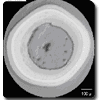
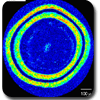
Advantages of measuring TRISO particles with the Hinds Instruments 2-MGEM:
No sample rotation is needed.
2-MGEM data is taken as a function of x- and y- position, making it possible to construct an image of the various measured parameters. All of the previous techniques are only able to measure at single points.
Optical resolution <4 microns
The 2-MGEM measures 8 parameters, which can then be reduced to the diattenuation N and the principal direction. The quantities N and cannot be measured simultaneously using any of the older techniques.
The 2-MGEM measures each of the 8 parameters to ~0.001; previous measurements of OPTAF were accurate to ~0.01. The 2-MGEM is 10 times more accurate. This accuracy is critical because the variations in the diattenuation from processing conditions are often as small as 0.002.
Polarymetr Muellera Exicor 150XT

System Exicor do wygenerowania pełnej macierzy Muellera pozwalających na wyznaczenia właściwości polaryzacyjnych.
W polarymetrze Muellera 150XT zastosowano cztery modulatory fotoelastyczne (PEM), który zapewniają jednoczesne pomiary wszystkich szesnastu elementów matrycy Muellera i pełne właściwości polaryzacyjne próbki w ułamku sekundy.
Ten najnowszy instrument w portfolio Hinds Instruments, jest stosowany przez jednostki badawczo-naukowe i przemysłowe na całym świecie, do charakteryzacji elementów optycznych, na produkcji i w kontroli jakości.
Hinds Instruments introduces the latest and most advanced Mueller Matrix Polarimeter System for challenging research and industrial process applications requiring ultra high sensitivity and repeatability in distinguishing specific, low level Mueller Matrix elements. The new Exicor®XT series 4 PEM Mueller Polarimeter system, developed by our Applications Research Group in a joint project with the Kahr group of NYU, has delivered best-in-class solutions to leading customers in Optics research, Crystals research, Flat Panel Display and Optical Lithography Applications. These include applications requiring the measurement of:
- All 16 Mueller matrix elements
- Low-level linear and circular retardation, with minimal interaction between them
- All 6 polarization parameters (linear retardation – magnitude and angle; circular retardation – magnitude; linear diattenuation – magnitude and angle; and circular diattenuation – magnitude) of DUV light, with minimal interaction between them.
- Linear and circular retardation, where there is significant interaction between them.
achromatic retardation film sample;
c cut quartz sample 4x6
Features:
- Simultaneous measurements of all 16 Mueller matrix elements
- Determination of all polarization parameters and estimation for depolarization
- Highest available sensitivity
- Laboratory grade repeatability
- Customization for polarization properties of interest available on request
- Minimal wavelength restrictions (DUV to IR)
- Normal incident and oblique incident angle capability
- Floor mount or bench top design, with flexible stages for adding custom part holders
- Measurement cycle times appropriate for production processes
- Software packages with extensive data analysis features
Dostawcy
